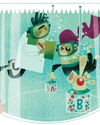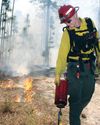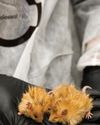試す 金 - 無料
The Old-Fashioned Dream Lab
Muse Science Magazine for Kids
|November/December 2016
How Did Scientists Without Modern Technology Study the Dreaming Mind?

Alfred Maury lies asleep in bed. His assistant brushes a feather over Maury’s lips, sweeping the feather upward, tickling the sleeping man’s nose. Then the assistant shakes Maury awake and asks, “What were you dreaming?”
Maury replies in a drowsy voice. “A man was tearing a mask off of my face. It was torture!”
Torture? No, it was science. Welcome to the old-fashioned dream laboratory.
Alfred Maury’s conversation is a fictional reconstruction, but the French scholar really performed the feather experiment in the nineteenth century. Today, scientists have sophisticated technology to help them study the dreaming brain. Electroencephalography (EEG) machines can record the electrical activity of the brain during sleep. Functional magnetic resonance imaging (fMRI) captures images of blood flow in the brain. These tools allow scientists to see what’s going on in the brain when we dream. But before these inventions, sleep and dream researchers had to get creative. They took to their beds and experimented on their own dreaming minds.
Two French scholars of the mid nineteenth century revolutionized dream study—not with their conclusions but with their methods. Their names were Alfred Maury and Léon d’Hervey de Saint-Denys. Grab a feather and let’s visit their labs.

The Guillotine Dream
このストーリーは、Muse Science Magazine for Kids の November/December 2016 版からのものです。
Magzter GOLD を購読すると、厳選された何千ものプレミアム記事や、10,000 以上の雑誌や新聞にアクセスできます。
すでに購読者ですか? サインイン
Muse Science Magazine for Kids からのその他のストーリー

Muse Science Magazine for Kids
ANIMAL FIREFIGHTER TO THE RESCUE
Can animals help manage the risks of deadly wildfires?
3 mins
Muse July 2025: The Story Behind Wildfires

Muse Science Magazine for Kids
FIRE DANGER
WHY THE RISK OF WILDFIRES KEEPS GROWING
4 mins
Muse July 2025: The Story Behind Wildfires

Muse Science Magazine for Kids
The Miller NEW Normal
WHAT TODAY’S WILDFIRES TELL US ABOUT OUR FUTURE
8 mins
Muse July 2025: The Story Behind Wildfires

Muse Science Magazine for Kids
WOMEN AND FIREFIGHTING: A GOOD FIT
Jessica Gardetto is a firefighter. Her father was, too. “I grew up with my dad coming home smelling like wildfire and covered in soot,” she says.
1 min
Muse July 2025: The Story Behind Wildfires

Muse Science Magazine for Kids
What is happening on your fingertips when they get all wrinkly in a hot tub?
—Felix G., age 10, Montana
1 mins
Muse July 2025: The Story Behind Wildfires

Muse Science Magazine for Kids
WHEN the SMOKE CLEARS
THE LINGERING EFFECTS OF THE RECENT PACIFIC PALISADES AND ALTADENA EATON FIRES
6 mins
Muse July 2025: The Story Behind Wildfires

Muse Science Magazine for Kids
PICKING TEAMS
Keep it fair with a strategy that relies on geometry.
2 mins
Muse July 2025: The Story Behind Wildfires

Muse Science Magazine for Kids
SHAN CAMMACK
WILDLIFE BIOLOGIST AND FIRE SAFETY OFFICER
3 mins
Muse July 2025: The Story Behind Wildfires

Muse Science Magazine for Kids
Scientists Create Mice With Woolly Mammoth-Like Fur
RESEARCHERS AT A COMPANY IN TEXAS ARE WORKING TO CREATE A LIVING ANIMAL THAT RESEMBLES THE EXTINCT WOOLLY MAMMOTH. Recently, they produced mice with traits of the large mammal. The mice all have coats with mammoth-like fur, and some of the small mammals also have genes that help them store fat. Both features would help the animals survive in the cold Arctic, where the woolly mammoth once lived.
1 min
Muse July 2025: The Story Behind Wildfires

Muse Science Magazine for Kids
Cool Sunshade Added to the Nancy Roman Space Telescope
THE NANCY ROMAN SPACE TELESCOPE IS A NEW TELESCOPE THAT NASA IS BUILDING AND WILL LAUNCH INTO SPACE, LIKELY IN EARLY 2027.
1 min
Muse July 2025: The Story Behind Wildfires
Translate
Change font size

